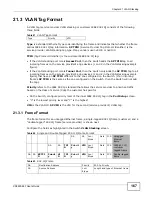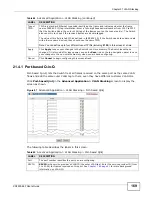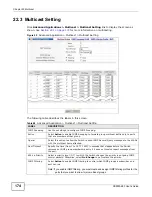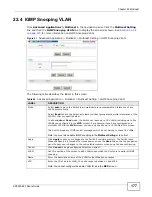
Chapter 22 Multicast
XS3900-48F User’s Guide
175
Unknown
Multicast Frame
Specify the action to perform when the Switch receives an unknown multicast frame.
Select Drop to discard the frame(s). Select Flooding to send the frame(s) to all ports.
Reserved
Multicast Group
The IP address range of 224.0.0.0 to 224.0.0.255 are reserved for multicasting on the
local network only. For example, 224.0.0.1 is for all hosts on a local network segment and
224.0.0.9 is used to send RIP routing information to all RIP v2 routers on the same
network segment. A multicast router will not forward a packet with the destination IP
address within this range to other networks. See the IANA web site for more information.
The layer-2 multicast MAC addresses used by Cisco layer-2 protocols,
01:00:0C:CC:CC:CC and 01:00:0C:CC:CC:CD, are also included in this group.
Specify the action to perform when the Switch receives a frame with a reserved multicast
address. Select Drop to discard the frame(s). Select Flooding to send the frame(s) to all
ports.
Port
This field displays the port number.
*
Settings in this row apply to all ports.
Use this row only if you want to make some settings the same for all ports. Use this row
first to set the common settings and then make adjustments on a port-by-port basis.
Note: Changes in this row are copied to all the ports as soon as you make them.
Immed. Leave
Select this option to set the Switch to remove this port from the multicast tree when an
IGMP version 2 leave message is received on this port.
Select this option if there is only one host connected to this port.
Normal Leave
Enter an IGMP normal leave timeout value (from 200 to 6,348,800) in miliseconds. Select
this option to have the Switch use this timeout to update the forwarding table for the
port.
In normal leave mode, when the Switch receives an IGMP leave message from a host on
a port, it forwards the message to the multicast router. The multicast router then sends
out an IGMP Group-Specific Query (GSQ) message to determine whether other hosts
connected to the port should remain in the specific multicast group. The Switch forwards
the query message to all hosts connected to the port and waits for IGMP reports from
hosts to update the forwarding table.
This defines how many seconds the Switch waits for an IGMP report before removing an
IGMP snooping membership entry when an IGMP leave message is received on this port
from a host.
Fast Leave
Enter an IGMP fast leave timeout value (from 200 to 6,348,800) in miliseconds. Select
this option to have the Switch use this timeout to update the forwarding table for the
port.
In fast leave mode, right after receiving an IGMP leave message from a host on a port,
the Switch itself sends out an IGMP Group-Specific Query (GSQ) message to determine
whether other hosts connected to the port should remain in the specific multicast group.
This helps speed up the leave process.
This defines how many seconds the Switch waits for an IGMP report before removing an
IGMP snooping membership entry when an IGMP leave message is received on this port
from a host.
Group Limited
Select this option to limit the number of multicast groups this port is allowed to join.
Max Group Num.
Enter the number of multicast groups this port is allowed to join. Once a port is registered
in the specified number of multicast groups, any new IGMP join report frame(s) is
dropped on this port.
Table 68
Advanced Application > Multicast > Multicast Setting (continued)
LABEL
DESCRIPTION
Summary of Contents for XS-3900-48F
Page 15: ...15 PART I User s Guide ...
Page 16: ...16 ...
Page 48: ...Chapter 2 Tutorials XS3900 48F User s Guide 48 ...
Page 62: ...Chapter 4 The Web Configurator XS3900 48F User s Guide 62 ...
Page 63: ...63 PART II Technical Reference ...
Page 64: ...64 ...
Page 227: ...Chapter 26 VLAN Mapping XS3900 48F User s Guide 227 ...
Page 320: ...Appendix A Common Services XS3900 48F User s Guide 320 ...
Page 332: ...Index XS3900 48F User s Guide 332 ...
















































